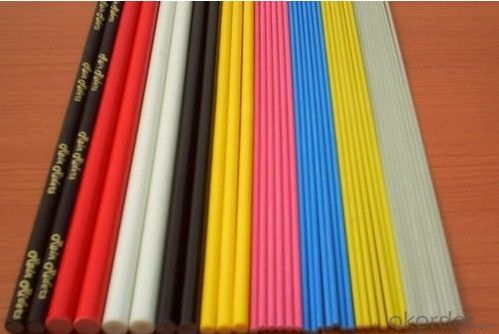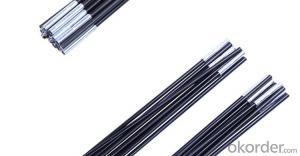Fiberglass Stick with High Quality
- Loading Port:
- China Main Port
- Payment Terms:
- TT OR LC
- Min Order Qty:
- -
- Supply Capability:
- -
OKorder Service Pledge
OKorder Financial Service
You Might Also Like
Specifications of Fiberglass Stick with HighQuality:
1. Fiberglass stake
2. Colorful,UV resistant
3. Good flexibility,impact resistant
4. UL,ISO9001,ROHS,
Performance of Fiberglass Stick with High Quality:
|
|
Applications of Fiberglass Stick with High Quality:
|
|

- Q:Can FRP pultrusion profiles be used in renewable energy projects?
- Certainly, FRP pultrusion profiles are capable of being used in renewable energy projects. They possess a wide range of advantages that make them suitable for various applications within the renewable energy sector. To begin with, FRP pultrusion profiles are both lightweight and strong, which makes them ideal for utilization in wind turbine blades. The lightweight nature of FRP materials allows for increased efficiency in wind energy generation by reducing the load on the turbine, thus enhancing overall performance. Furthermore, the high strength-to-weight ratio of FRP profiles ensures durability and longevity, even in severe environmental conditions. Additionally, FRP pultrusion profiles display exceptional resistance to corrosion, which renders them suitable for employment in solar panel mounting structures and other components exposed to moisture and outdoor elements. This corrosion resistance ensures that FRP profiles maintain their structural integrity and performance over an extended period, diminishing the need for frequent maintenance and replacement. Furthermore, FRP pultrusion profiles can be customized to meet specific project requirements, providing flexibility in design and functionality. They can be easily molded into complex shapes and sizes, facilitating the creation of innovative and efficient solutions for renewable energy projects. Moreover, FRP materials are non-conductive and possess excellent electrical insulation properties, making them suitable for use in electrical enclosures and support structures for renewable energy systems such as solar power plants. In conclusion, FRP pultrusion profiles can be effectively utilized in renewable energy projects due to their lightweight, strong, corrosion-resistant, customizable, and electrically-insulating properties. These characteristics make FRP profiles a reliable and sustainable choice for various applications within the renewable energy sector.
- Q:How do FRP pultrusion profiles perform in high-humidity environments?
- FRP pultrusion profiles perform exceptionally well in high-humidity environments. The inherent properties of fiberglass reinforced plastic, such as corrosion resistance and moisture resistance, make these profiles highly durable and resistant to degradation caused by exposure to moisture and humidity. Additionally, FRP pultrusion profiles do not rot, warp, or rust, making them an ideal choice for applications in high-humidity environments.
- Q:Can FRP pultrusion profiles be used in the telecommunications and data communication industry?
- Yes, FRP pultrusion profiles can be used in the telecommunications and data communication industry. These profiles offer several advantages such as high strength-to-weight ratio, corrosion resistance, and electrical insulation properties. They can be used for applications such as cable trays, antenna supports, equipment enclosures, and infrastructure components, providing a durable and reliable solution for the industry's needs.
- Q:Are FRP pultrusion profiles resistant to caustic solutions?
- FRP pultrusion profiles are known for their resistance to caustic solutions. The combination of reinforcing fibers and the polymer matrix used in FRP pultrusion provides exceptional chemical resistance. Unlike traditional materials like steel or wood, which can be corroded or degraded by strong alkaline substances, FRP pultrusion profiles are highly resistant to chemical attack. This makes them suitable for industries that frequently encounter caustic solutions, such as chemical processing, wastewater treatment, and marine environments. However, it is important to refer to the manufacturer's specifications and guidelines to ensure compatibility between specific caustic solutions and the chosen FRP pultrusion profile.
- Q:Are FRP pultrusion profiles resistant to sulfuric acid?
- Yes, FRP pultrusion profiles are generally resistant to sulfuric acid due to the corrosion-resistant properties of the fiber-reinforced plastic material. However, it is important to consider the concentration and temperature of the sulfuric acid, as extreme conditions can potentially affect the resistance of FRP profiles.
- Q:Are FRP pultrusion profiles resistant to electromagnetic interference?
- Yes, FRP pultrusion profiles are generally resistant to electromagnetic interference (EMI). The use of fiberglass reinforced plastic (FRP) in pultrusion profiles provides excellent electrical insulation properties, which help to minimize the effects of electromagnetic interference. Unlike metals, which are conductive and can easily transmit electrical signals, FRP materials have high dielectric strength and low electrical conductivity. This makes FRP pultrusion profiles less susceptible to EMI and allows them to act as barriers to electromagnetic waves. Additionally, FRP materials can be further enhanced with additional layers or coatings to increase their EMI shielding effectiveness if required. Overall, FRP pultrusion profiles are a reliable choice for applications where resistance to electromagnetic interference is important.
- Q:Are FRP pultrusion profiles resistant to fungal growth?
- FRP pultrusion profiles are generally resistant to fungal growth. The composite materials, like resins and fibers, used in pultrusion possess inherent resistance to biological degradation, including attacks from fungi. The non-porous nature of FRP pultrusion profiles also poses difficulties for fungi to penetrate and grow on the surface. Furthermore, the manufacturing process involves curing the composite materials at high temperatures, which adds to their resistance against fungal growth. However, it is important to acknowledge that no material is entirely impervious to fungal growth in all conditions. Factors such as high humidity, prolonged exposure to moisture, and inadequate maintenance practices can still contribute to fungal growth on FRP pultrusion profiles, albeit to a lesser extent compared to materials like wood or metal. Regular inspection and appropriate cleaning are crucial to sustain the fungal resistance of FRP pultrusion profiles throughout their lifespan.
- Q:Can FRP pultrusion profiles be used in the construction of chemical storage tanks?
- FRP pultrusion profiles have the capability to be utilized in the construction of chemical storage tanks. Their exceptional resistance to corrosion is well-known, making them an optimal choice for storing a wide array of chemicals. Pultrusion profiles, created by pulling fiber reinforcements through a resin bath and then through a heated die, possess a high strength-to-weight ratio, dimensional stability, and durability. Most chemicals do not cause a reaction with FRP pultrusion profiles, and they can withstand harsh environments, including exposure to corrosive substances. The profiles have a low permeability, which prevents chemicals from seeping through the tank walls. Moreover, FRP profiles can be customized to meet specific requirements, enabling the construction of tanks in various shapes and sizes. In addition, FRP pultrusion profiles offer other benefits, such as easy installation, reduced maintenance, and a long service life. Being lightweight simplifies transportation and installation processes. The low maintenance requirements of FRP tanks contribute to minimizing downtime and reducing overall costs. With appropriate design and construction, FRP pultrusion profiles can provide reliable and long-lasting solutions for chemical storage tank applications.
- Q:Can FRP pultrusion profiles be used in the agricultural and farming industry?
- Yes, FRP pultrusion profiles can be used in the agricultural and farming industry. These profiles are lightweight, durable, and resistant to corrosion, making them suitable for various applications such as structural supports, fencing, gates, and equipment enclosures. They offer high strength-to-weight ratio, excellent weather resistance, and can withstand harsh environmental conditions commonly found in agricultural settings. Additionally, FRP profiles are non-conductive and have low thermal conductivity, which makes them ideal for electrical insulation and thermal management in farm equipment.
- Q:Can not use glass steel support column, the main support for the door
- Can not. Strength is not good. It is recommended to use FRP for exterior decoration, with steel skeleton inside.
1. Manufacturer Overview |
|
|---|---|
| Location | |
| Year Established | |
| Annual Output Value | |
| Main Markets | |
| Company Certifications | |
2. Manufacturer Certificates |
|
|---|---|
| a) Certification Name | |
| Range | |
| Reference | |
| Validity Period | |
3. Manufacturer Capability |
|
|---|---|
| a)Trade Capacity | |
| Nearest Port | |
| Export Percentage | |
| No.of Employees in Trade Department | |
| Language Spoken: | |
| b)Factory Information | |
| Factory Size: | |
| No. of Production Lines | |
| Contract Manufacturing | |
| Product Price Range | |
Send your message to us
Fiberglass Stick with High Quality
- Loading Port:
- China Main Port
- Payment Terms:
- TT OR LC
- Min Order Qty:
- -
- Supply Capability:
- -
OKorder Service Pledge
OKorder Financial Service
Similar products
New products
Hot products
Related keywords




























